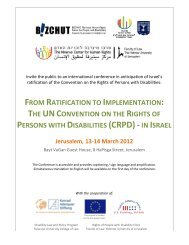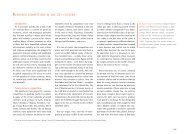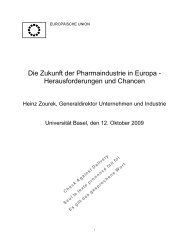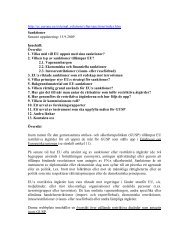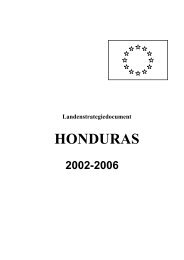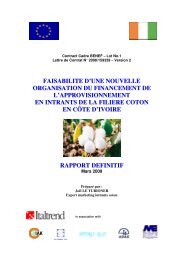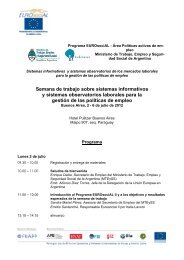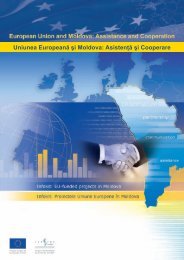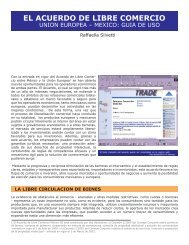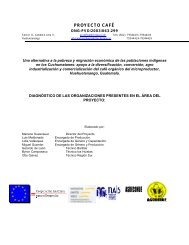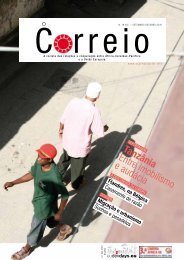Vision Group Report: Invigorating the Indonesia-EU Partnership
Vision Group Report: Invigorating the Indonesia-EU Partnership
Vision Group Report: Invigorating the Indonesia-EU Partnership
Create successful ePaper yourself
Turn your PDF publications into a flip-book with our unique Google optimized e-Paper software.
Figure 2: Effects on <strong>Indonesia</strong>n trade values by sectors, in<br />
millions of 2004 US dollars, cumulative changes in 2030 as<br />
compared to <strong>the</strong> baselin<br />
exPort IMPort<br />
In terms of effects on trade volumes, <strong>Indonesia</strong>n<br />
export of light industries and transport equipment is<br />
estimated to increase considerably. And as <strong>the</strong>se sectors<br />
constitute toge<strong>the</strong>r a large share of total <strong>Indonesia</strong>n<br />
exports, when measured in constant prices, <strong>Indonesia</strong>n<br />
exports of goods and services in 2030 is going to be<br />
higher by USD 9.8 billion (as compared to a situation<br />
without <strong>the</strong> FTA). Imports of (in particular) chemicals,<br />
transport equipment and agricultural products and<br />
processed food are also set to expand by around USD<br />
7.7 billions. Therefore, <strong>the</strong> overall <strong>Indonesia</strong>n trade<br />
balance in <strong>the</strong> long run will improve by around USD<br />
2 billion.<br />
III. beyond a shallow fta<br />
Moreover, <strong>the</strong>re are grounds to believe that if a deep<br />
and comprehensive trade agreement is going beyond<br />
simple tariff dismantling, is implemented, <strong>the</strong> economic<br />
gains are going to be even more substantial. A typical<br />
<strong>EU</strong> FTA contains many provisions going beyond tariff<br />
liberalization, such as approximation/mutual recognition<br />
of standards, enhancing competition, liberalisation of<br />
barriers to trade in services, opening up procurement<br />
markets etc. These provisions usually lower non-tariff<br />
barriers to trade and enhance trade creation leading to<br />
bigger overall welfare gains.<br />
For instance, <strong>the</strong> dynamic results of <strong>the</strong> simulated FTA point<br />
out an increase by 2% in new FDI inflows into <strong>Indonesia</strong><br />
in <strong>the</strong> short and medium-run (2016-2020) and by over 4%<br />
of new FDI inflows into <strong>Indonesia</strong> by 2030 (as compared to<br />
<strong>the</strong> situation in 2030 simulated without <strong>the</strong> FTA).<br />
46<br />
-1000 1000<br />
millions of 2004 US dollars<br />
3000 5000 7000<br />
agri&food<br />
minerals<br />
fuels<br />
chemicals<br />
transport eq.<br />
light<br />
o<strong>the</strong>r<br />
manufacturing<br />
services<br />
<strong>Indonesia</strong>n exports total <strong>Indonesia</strong>n exports to <strong>the</strong> <strong>EU</strong><br />
-1000 1000<br />
millions of 2004 US dollars<br />
3000 5000 7000<br />
agri&food<br />
minerals<br />
fuels<br />
chemicals<br />
transport eq.<br />
light<br />
o<strong>the</strong>r<br />
manufacturing<br />
services<br />
<strong>Indonesia</strong>n imports total <strong>Indonesia</strong>n imports from <strong>the</strong> <strong>EU</strong><br />
Possible additional effects, which can be brought about<br />
by <strong>the</strong> liberalisation of barriers to trade in services are<br />
perhaps <strong>the</strong> most interesting in this case. Recent study<br />
exploring consequences of <strong>the</strong> removal of restrictions on<br />
services by developing countries (CIE, 2010) pointed out<br />
that <strong>the</strong> effects of such an action on <strong>Indonesia</strong> would be in<br />
<strong>the</strong> range of 0.1% of its GDP. Most likely, such move will<br />
stimulate substantial additional FDI flows, in particular to<br />
<strong>the</strong> financial intermediation sector.<br />
Iv. costs of doInG nothInG<br />
One may think about o<strong>the</strong>r possible scenarios for <strong>the</strong> <strong>EU</strong>-<br />
<strong>Indonesia</strong> trade relations. In case no FTA is concluded<br />
while some bilateral agreements are taking place with o<strong>the</strong>r<br />
partners, trade diversion is most likely going to dominate<br />
any o<strong>the</strong>r effects with adverse consequences for <strong>Indonesia</strong>.<br />
On top of this, <strong>the</strong> GSP system undergoing changes is also<br />
going to impact upon existing trade flows. Stating how<br />
large welfare changes <strong>the</strong>se might be is beyond <strong>the</strong> scope of<br />
this exercise. Never<strong>the</strong>less it is useful to remember that <strong>the</strong><br />
changes simulated here show only one possible direction<br />
of events.<br />
v. trade and Poverty redUctIon<br />
Since <strong>the</strong> possible FTA raises concerns about its impact on<br />
poverty, we turn now to <strong>the</strong> topic of how trade influences<br />
poverty and what kind of effects can be expected in <strong>the</strong><br />
case of <strong>the</strong> FTA between <strong>the</strong> <strong>EU</strong> and <strong>Indonesia</strong>. The dynamic<br />
GTAP simulations described above suggest an overall<br />
rise in <strong>the</strong> <strong>Indonesia</strong>n wages of 1.5% as a result of a<br />
trade agreement. This is a strong indication that income<br />
levels in <strong>Indonesia</strong>, including for <strong>the</strong> poorer segments of<br />
<strong>the</strong> population will be positively affected. Returns to land<br />
(important for <strong>the</strong> rural population) will increase in <strong>the</strong><br />
long run as well, but <strong>the</strong> change is going to be smaller. It is<br />
also important to emphasize that o<strong>the</strong>r supporting policies<br />
will certainly have a strong impact on poverty reduction,<br />
alongside <strong>the</strong> impact of trade policy.<br />
Economic literature on <strong>the</strong> link of trade and poverty<br />
suggests that contrary to <strong>the</strong> general perception that trade<br />
may harm <strong>the</strong> poor, trade is in general poverty alleviating<br />
(see Winters et al. for a survey of applied studies). Whe<strong>the</strong>r<br />
trade liberalisation has a positive impact on poverty<br />
depends <strong>the</strong>refore on <strong>the</strong> development of markets for<br />
unskilled labour and often complementary domestic reforms<br />
are needed to enhance <strong>the</strong> ability of poorer households




